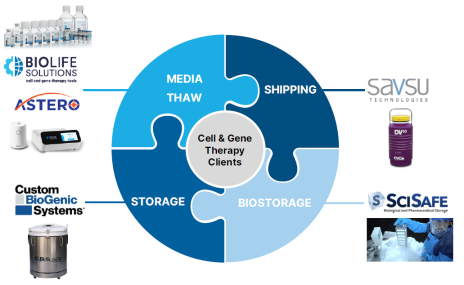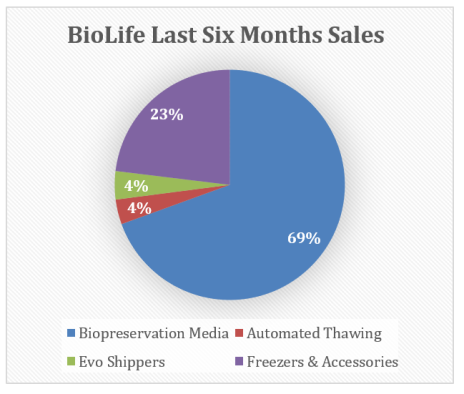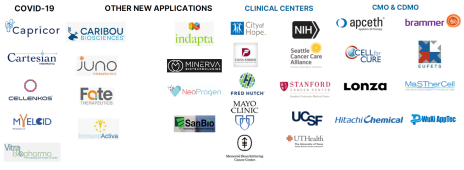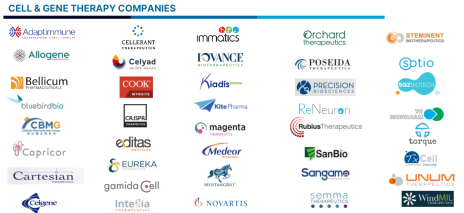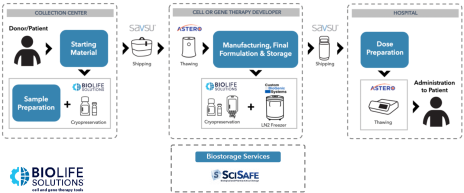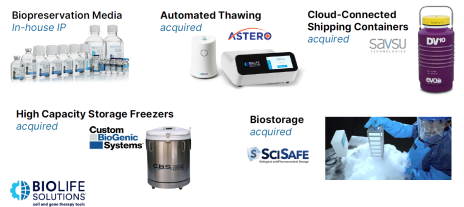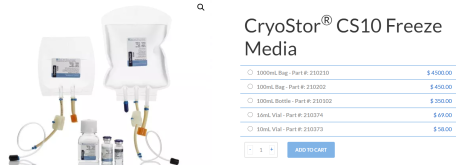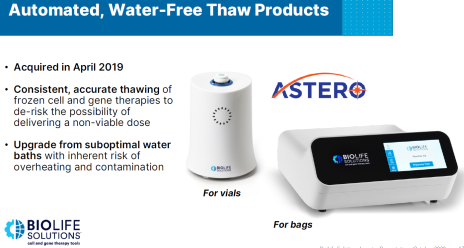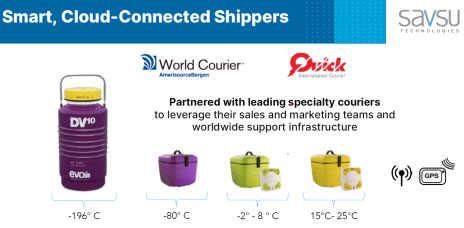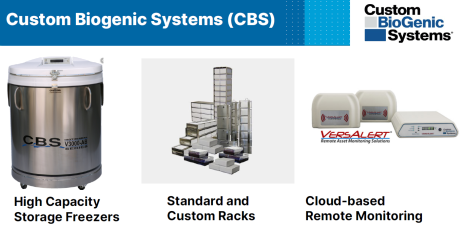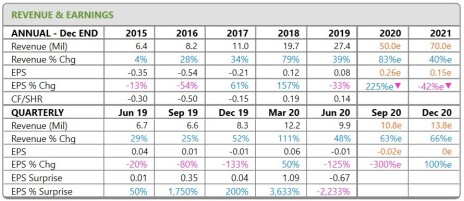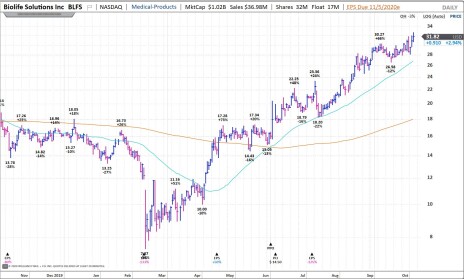This month we’re jumping into a small MedTech company that represents a picks and shovels play on the cell and gene therapy market. It makes biopreservation media and storage solutions for cutting-edge treatments, including Kite’s (owned by Gilead) CAR T-cell therapies YESCARTA and TECARTUS.
It’s a high growth company with exposure to both clinical trial and commercial-stage therapies. Covid-19 therapies and vaccines are part of the mix too. And there is an M&A angle that’s increasingly relevant.
The stock appears to have huge upside over the coming years. And we’ll get an update from management almost immediately after you read my reports since the company reports Q3 earnings after the close today.
All the details are inside. Enjoy!
Cabot Small Cap Confidential 258
[premium_html_toc post_id="219216"]
The Big Idea
The cell and gene therapy market is one of the fastest growing and most exciting areas of medicine. Analysts see it growing at an average clip of 30% through 2025, powered by expected approvals of more therapies over the next five years.
There are a lot of ways investors can play the strength. Biotech companies that are investing in R&D to commercialize therapies are one way. Then there are the picks and shovels-type companies, the contract manufacturers, tools and media suppliers and logistics providers that help researchers and doctors develop, manufacture, transport and deliver therapies to patients.
The picks and shovels route is the way we’re going today. But before we get into that, let’s cover some basics on this market.
CAR T-cell therapy represents one of the biggest breakthroughs in the fight against cancer. It involves extraction of T cells from a patient’s blood, adding an artificial receptor that turns the cells into cancer-killing missiles, then infusing the cells back into the patient through an IV so they can multiply and attack tumor cells.
Gene therapy involves introduction of genetic material into cells to compensate for abnormal genes or to make a beneficial protein. It is, of course, extremely complex. Researchers must figure out exactly how to deliver the genes (i.e. with a vector to carry the gene), how to target them to particular cells and how to make sure the new genes can be controlled by the body.
There are several approved CAR T-cell and gene therapies already, including Kite’s YESCARTA, for certain types of B-cell lymphoma, Novartis’ KYMRIAH for certain types of B-cell lymphoma and leukemia, Novartis’ ZOLGENSMA for spinal muscular atrophy and Kite’s TECARTUS, which was just approved in 2020, for relapsed or refractory mantle cell lymphoma.
The road to FDA approval for these treatments was long, they are incredibly expensive, and the reimbursement landscape is very much in flux.
Also, storage and handling of these therapies is incredibly complex due to the sensitivity of the materials. Living cells can’t just be pulled out of a body, poured into a vial and placed on a shelf to be used later. The materials require just the right biopreservation media, temperature-controlled storage containers and freeze/thaw equipment to keep them alive and effective.
These are precisely the types of the solutions offered by the small company we’re investing in today. It’s a pure-play provider of bioproduction tools for the cell and gene therapy market. It’s growing organically, as well as through acquisitions, as the fragmented industry begins to consolidate.
The Company
BioLife Solutions (BLFS) designs and manufactures bioproduction tools, hypothermic storage solutions and cryopreservation freeze media for the tissue engineering, cell therapy and gene therapy markets. Products include biopreservation media, automated thawing devices, cloud-connected shipping containers and freezer technologies.
The company’s products help maintain the health and function of biologic source material and finished products throughout the manufacturing, distribution and clinical administration processes. In short, BioLife’s products keep tissues and cells from getting damaged or dying.
Ensuring these materials are effective when they reach their destination is critical for the patient for obvious reasons, but also for the suppliers.
Let’s say CAR-T cells are exposed to environmental factors before being injected into a patient’s body and are less effective than they should have been. In that scenario the patient clearly suffers. But so too does the company providing the therapy since payors will only reimburse if there is an initial and durable response from treatment.
Cells and tissues need to be in the best possible condition to maintain effectiveness. BioLife’s solutions play an important role in achieving that goal.
“It’s imperative that the cells arrive alive to elicit the desired therapeutic response. Dead cells don’t cure cancer. With the emerging reimbursement paradigm of ‘pay on cure’, cell and gene therapy developers must do everything possible to reduce the risk of administering a non-viable dose to the patient, since payment is predicated on a positive patient response.” Mike Rice, CEO of BioLife, August 2019
The company, which has a market cap of $1 billion, was primarily in the business of selling biopreservation media prior to 2019. This was a nice little business that grew by 34% in 2017 and by 79% in 2018, which was also the first year BioLife turned a profit (adjusted EPS of $0.12).
But it was a very small business, generating just under $20 million in revenue a year and highly dependent on a few customers. BioLife needed to diversify its product offerings and diversify the customer base.
In 2019 it acquired three businesses – Astero, SAVSU and Custom Biogenic Systems (CBS) – which added complementary products in thawing, shipping and freezing solutions.
Then in October, BioLife snapped up SciSafe for $30 million. The acquisition should add more than 20% to the revenue base, and be accretive to profits, in 2021.
The total revenue impact of these acquisitions wasn’t huge in 2019, when revenue climbed 39% to $27.4 million. But the strategic shift to supplement organic growth with M&A was significant. That trend is likely to continue.
Over the last six months roughly 30% of revenue has been added through M&A. BioLife is on track to grow by 50% this year, delivering $50 million in revenue. BioLife is also seen growing adjusted EPS by over 200% from 2019, to $0.26.
The company still generates most of its revenue from biopreservation media (69% of revenue over the last six months, versus 94% over the same period in 2019). But the revenue base is much more diversified and the company now has a healthy business selling freezers and accessories (23% of revenue), as well as a foothold selling cloud-connected shipping containers (4% of revenue) and automated thawing devices (4% of revenue).
As the company’s solutions get more embedded in manufacturing and distribution processes, BioLife is becoming a more meaningful player in the bioproduction solutions market. Customers have used its products in roughly 450 clinical trials, including at least nine focused on Covid-19 therapies and vaccines.
Use of its products is growing in approved therapies as well, including Kite’s CAR T-cell therapies YESCARTA and TECARTUS, just to name a couple.
There’s no doubt BioLife is pushing on the gas peddle to drive growth. That requires capital.
To help on that front on May 22 the company sold an 18% equity stake to Casdin Capital for $20 million. The offering was priced at 10.5 a share (BLFS has tripled since). Then, on July 7 BioLife raised an additional $86 million through a secondary offering priced at 14.5 (BLFS has more than doubled since). These capital raises are intended to help BioLife pursue more M&A opportunities.
Products & Platform
BioLife is trying to build out a portfolio of solutions that covers all steps of customer workflows. That’s a very rational way to attack the opportunity as it allows for pointed acquisitions to fill in the gaps.
The image below shows this workflow, as well as where some of BioLife’s media, thawing devices, shipping containers and freezer technologies fit in the process.
And the following image shows the biggest product categories. Note that because of recent acquisitions in 2019 and 2020, many of BioLife’s solutions still retain the brand name of the acquired company/product.
Let’s talk about the major solutions in each of BioLife’s product lines.
Biopreservation Media
HypoThermosol: BioLife’s HypoThermosol storage solutions are serum-free, protein-free media used to preserve cells and tissue materials at 2-8°C during storage and transport. They help reduce temperature-induced molecular cell stress responses that occur during chilling and re-warming of biologics, intermediate products, and final cell products.
CryoStor: CryoStor is the family of lower-temperature freeze media solutions that are companions to the HypoThermosol storage solutions. They are used for cryopreservation of biologics at -70 to -196°C to help reduce stress on cells during the freezing and thawing process. CryoStor products are pre-formulated with USP grade DMSO (2%, 5% and 10% concentrations), a permeant solute cryoprotective agent which helps mitigate damage from the formation of intracellular ice.
Automated, Water-Free Thawing Products
ThawSTAR: ThawSTAR is BioLife’s family of automated thawing devices that was brought in house through the $12.5 million Astero Bio acquisition in 2019. They are used to thaw out cryovials and cryobags containing frozen cell and gene therapies. These tools replace non-standardized manual methods of cell thawing, including swirling frozen vials in water baths and warming vials by hand, that risk contamination and/or overheating.
Cloud Connected Shipping Containers
SAVSU: An August 2019 acquisition brought the remaining 56% of SAVSU into BioLife, for a price of approximately $35.8 million, funded through BioLife common stock. SAVSU specializes in making precision cold chain management tools for cell and gene therapies, including smart shippers that are connected to a cloud-based communications system that permits real-time tracking. While a small slice of revenue today, the opportunity to grow this business is meaningful as more therapies move to commercial-scale distribution.
Freezer & Storage Devices
Custom Biogenic Systems (CBS): In November 2019 BioLife acquired CBS for $15 million, paid in stock and cash. CBS makes liquid nitrogen laboratory freezers and cryogenic equipment as well as a related cloud-based monitoring system that continuously assesses biologic sample storage conditions and alerts equipment owners if a fault condition occurs.
SciSafe: On October 1, 2020 BioLife announced it closed the $30 million acquisition of SciSafe, using a combination of cash and stock. SciSafe is a multi-facility provider of biological materials storage (NJ, MA, UT) to the cell and gene therapy and pharmaceutical industries. It also offers cold chain logistics solutions using company-owned vehicles. The company has been averaging 47% growth since 2016 and should add roughly $9 million in sales in 2021.
Growth Initiatives
Diversify Revenue and Customer Base Through Acquisitions: A significant amount of BioLife’s growth has come through acquiring complementary products. Management has indicated this trend will continue and has raised cash to advance M&A.
Grow Biostorage Segment: Biostorage is a rapid-growth area of the market as cell and gene therapy clusters spring up around the world and more therapies are commercialized. BioLife’s recent acquisitions have helped secure relationships with several Top Five global pharma companies and once it becomes easier to complete projects there could be a significant backlog of demand for freezers.
Cross-Sell: As BioLife adds more products to its pantry and its customer base expands there are more opportunities to cross-sell. Of recent note, the acquisition of SciSafe could open many doors for selling CryoStor, HypoThermosol and ThawSTAR solutions, as well as those acquired from SAVSU and CBS.
Vertical Integration: As BioLife adds more pieces to the company there arise opportunities to simplify and/or build out value-added logistics services. For example, following the SciSafe acquisition BioLife can now use the CBS manufacturing facility to build walk-in freezer rooms for SciSafe facilities and/or use SAVSU smart-shipping containers for inbound and outbound shipments of SciSafe biologic materials.
The Business Model
BioLife generates revenue from the sale of products, devices and consumable as well as from leases for its shipping containers. It’s a straightforward business model common to the MedTech space. Over the last six months BioLife has generated 73% of revenue from the U.S., 14% from Canada and 11% from EMEA.
The Bottom Line
BioLife grew revenue by 79% in 2018 and by 39% (to $27.4 million) in 2019, when adjusted EPS was $0.08. Over the first six months of 2020 revenue has grown by 77%. Revenue was up by 48% in Q2, which was heavily impacted by the onset of the pandemic. M&A has been a major driver of growth, as has increased sales of biopreservation media, which grew by 27% in the first half of 2020. Some of that is due to stocking up in Q2 due to Covid-19 related concerns.
At a high level the Covid-19 pandemic is driving higher demand for some solutions, like media. However, as a provider of capital equipment (like freezers) BioLife has also seen some negative impacts. Until it is easier to travel and install equipment these areas of the business will likely underperform their true potential. This could lead to a nice rebound down the road, however.
On the bottom line, BioLife’s gross margins are dropping due to the growth in lower-margin products brought in through M&A (media is the most profitable product group). Coupled with investments to build out manufacturing capacity and improve quality control, along with higher headcount, BioLife’s operating expenses grew materially in Q2. That means adjusted EPS fell to a loss of -$0.01 versus a profit of $0.04 in Q2 2019. In the first half of 2020 adjusted EPS was $0.02 versus $0.11 in the first half of 2019.
Looking forward, BioLife is seen growing 2020 revenue by 83% to $50 million and 2021 revenue by 40% to $70 million. Adjusted EPS is seen jumping 225% to $0.26 this year then falling 40% to $0.15 in 2021. While 2020 figures afford some wiggle room, I expect 2021 actual results could be materially different from consensus estimates due to evolving trends in the business and M&A.
The company ended Q2 2020 with $30 million in cash and equivalents, and it added $86 million more from the secondary offering in July. Subtracting $15 million for the SciSafe acquisition means BioLife should have around $100 million in cash at the end of Q3.
Risk
Customer Concentration: In the last quarter (Q2 2020) BioLife generated 25% of revenue from two customers. Should that relationship deteriorate without an uptick in busines with other/new customers BioLife’s revenue could be adversely impacted
Reliance on CryoStor: In the last quarter (Q2 2020) BioLife generated 62% of revenue from CryoStor media products. This product concentration is trending down as the company diversifies the product base (it was 82% in Q2 2019) but this is still something to be aware of.
M&A Risks: There is always risk to a growth-through-acquisition strategy and that applies here. Management must be vigilant in searching out complementary products that its customers will want and which can be acquired for a reasonable price and profit margin profile.
Competition: BioLife is a small player in a consolidating industry. Bigger players have a lot more firepower and scale.
Small Company, Unknown Stock: This company is flying under the radar and can be subject to a short attack or other negative press that can hurt the stock. The flipside is that if management continues to execute and the story gets out, BLFS has a ton of upside.
Competition
BioLife faces competition from many small, privately owned players, as well as a few much larger ones. Larger competitors include Thermo-Fisher Scientific (TMO), Cryoport (CYRX), MilliporeSigma and Princeton Cryotech.
The Stock
Trading Volume: BLFS trades an average of 318,000 shares daily, worth just over $10 million.
Historical Price: BLFS was an uninspiring stock prior to the pandemic. Shares traded mostly between 13 and 21 for much of 2019. Shares hit 16.7 in February, slid to 12 just prior to the pandemic, then fell below 8 during the market crash. The stock was back to 12 in early-May then consolidated in the 15 to 17.5 range following the Q1 result this spring. BLFS advanced again after the secondary stock offering in July and pulled back to 18 upon the Q2 result in early-August. The stock has advanced steadily since then and hit 30.3 in early-October before a 12% pullback. Over the last three weeks BLFS has walked steadily to a new all-time high to trade near 32.5 today.
Valuation & Projected Price Target: BLFS trades with a 2020 EV/Revenue multiple of 18.3 and a 2021 EV/Revenue multiple of 13. I think there’s potential for multiple expansion if the bull thesis continues to play out in Q3 and looks intact into 2021. If we roll the clock forward to this time next year and assume BLFS trades at a 2021 EV/Revenue multiple of 20 we get to roughly 50% upside. That seems like a balanced approach to me and yields a price target near 50.
Buy Range: In the near-term, look to buy down to support around 26 and up to 35. Following the Q3 earnings report tonight I will update my rating and outlook. Average in!
The Next Event: BioLife reports Q3 earnings after the close today.
Updates on Current Recommendations
| Stock Name | Date Bought | Price Bought | Price on 11/4/20 | Profit | Rating |
| Accolade (ACCD) | 8/6/20 | 40.09 | 34.28 | -14% | Buy a Half |
| AppFolio (APPF) | 6/2/17 | 30.45 | 156.63 | 414% | Hold |
| Arena Pharmaceuticals (ARNA) | 2/2/18 | 38.93 | 87.69 | 125% | Buy |
| Avalara (AVLR) | 2/1/19 | 40.05 | 158.25 | 295% | Buy |
| Cardlytics Inc (CDLX) | 9/6/19 | 37.97 | 83.45 | 120% | Hold |
| Cerence (CRNC) | 10/1/20 | 49.83 | 61.28 | 23% | Buy |
| Everbridge (EVBG) | 12/2/16 | 15.51 | 113.10 | 629% | Hold |
| EverQuote (EVER) | — | — | — | — | Sold |
| Fiverr Intl (FVRR) | 3/5/20 | 32.32 | 159.15 | 392% | Hold 3/4 |
| Goosehead Insurance (GSHD) | 9/7/18 | 31.35 | 123.75 | 295% | Hold 3/4 |
| Inspire Medical (INSP) | 10/4/19 | 58.54 | 166.00 | 184% | Hold 3/4 |
| Karyopharm Therapeutics (KPTI) | 5/7/20 | 19.49 | 15.17 | -22% | Hold |
| Palomar Holdings (PLMR) | 6/4/20 | 82.34 | 93.84 | 14% | Buy |
| Q2 Holdings (QTWO) | 4/1/16 | 23.81 | 96.99 | 307% | Buy |
| Repay Holdings (RPAY) | 7/2/20 | 25.04 | 25.96 | 4% | Buy |
| Repligen (RGEN) | 11/2/18 and 12/31/18 | 59.19 | 187.16 | 216% | Buy |
| Sprout Social (SPT) | 9/3/20 | 36.48 | 46.03 | 26% | Buy |
Please email me at tyler@cabotwealth.com with any questions or comments about any of our stocks, or anything else on your mind.
Glossary
Buy means accumulate shares at or around the current price.
Hold means just that; hold what you have. Don’t buy, or sell, shares.
Sell means the original reasons for buying the stock no longer apply, and I recommend exiting the position.
Sell a Half means it’s time to take partial profits. Sell half (or whatever portion feels right to you) to lock in a gain, and hold on to the rest until another ratings change is issued.
The next Cabot Small-Cap Confidential issue is scheduled for December 3, 2020.
Cabot Wealth Network
Publishing independent investment advice since 1970.
CEO & Chief Investment Strategist: Timothy Lutts
President & Publisher: Ed Coburn
176 North Street, PO Box 2049, Salem, MA 01970 USA
800-326-8826 | support@cabotwealth.com | CabotWealth.com
Copyright © 2020. All rights reserved. Copying or electronic transmission of this information is a violation of copyright law. For the protection of our subscribers, copyright violations will result in immediate termination of all subscriptions without refund. No Conflicts: Cabot Wealth Network exists to serve you, our readers. We derive 100% of our revenue, or close to it, from selling subscriptions to its publications. Neither Cabot Wealth Network nor our employees are compensated in any way by the companies whose stocks we recommend or providers of associated financial services. Disclaimer: Sources of information are believed to be reliable but they are not guaranteed to be complete or error-free. Recommendations, opinions or suggestions are given with the understanding that subscribers acting on information assume all risks involved. Buy/Sell Recommendations: All recommendations are made in regular issues or email alerts or updates and posted on the private subscriber web page. Performance: The performance of this portfolio is determined using the midpoint of the high and low on the day following the recommendation. Cabot’s policy is to sell any stock that shows a loss of 20% in a bull market or 15% in a bear market from the original purchase price, calculated using the current closing price. Subscribers should apply loss limits based on their own personal purchase prices.
